Family Law: Mediation, Spouse Abuse, Child Protection, Property Distribution
VerifiedAdded on 2023/04/22
|6
|1317
|219
AI Summary
This document discusses the various aspects of family law including mediation, spouse abuse, child protection, and property distribution. It covers the advantages and disadvantages of mediation, social and legal responses to spouse abuse, steps involved in child protection investigation, and fair distribution of property under Family Law Act 1975.
Contribute Materials
Your contribution can guide someone’s learning journey. Share your
documents today.
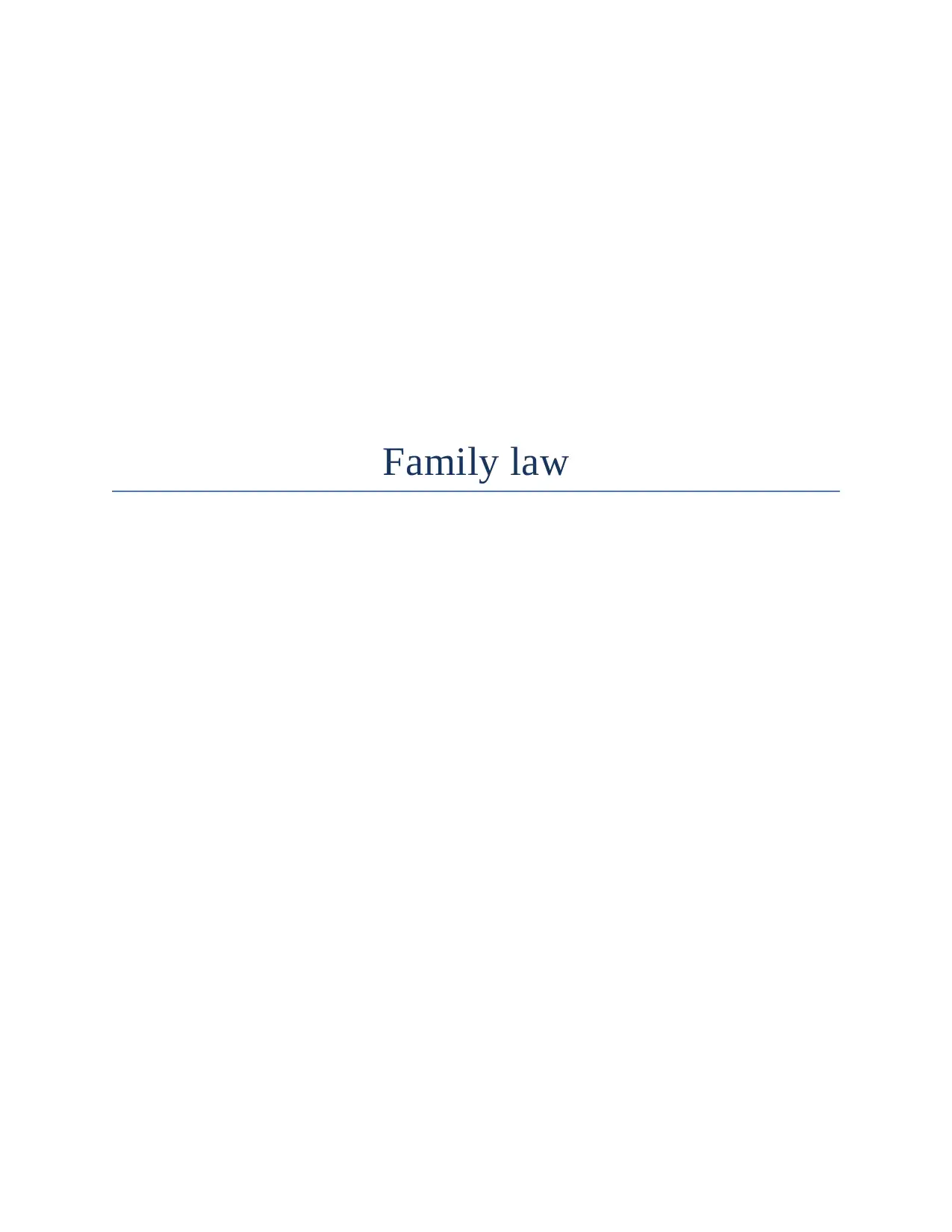
Family law
Secure Best Marks with AI Grader
Need help grading? Try our AI Grader for instant feedback on your assignments.
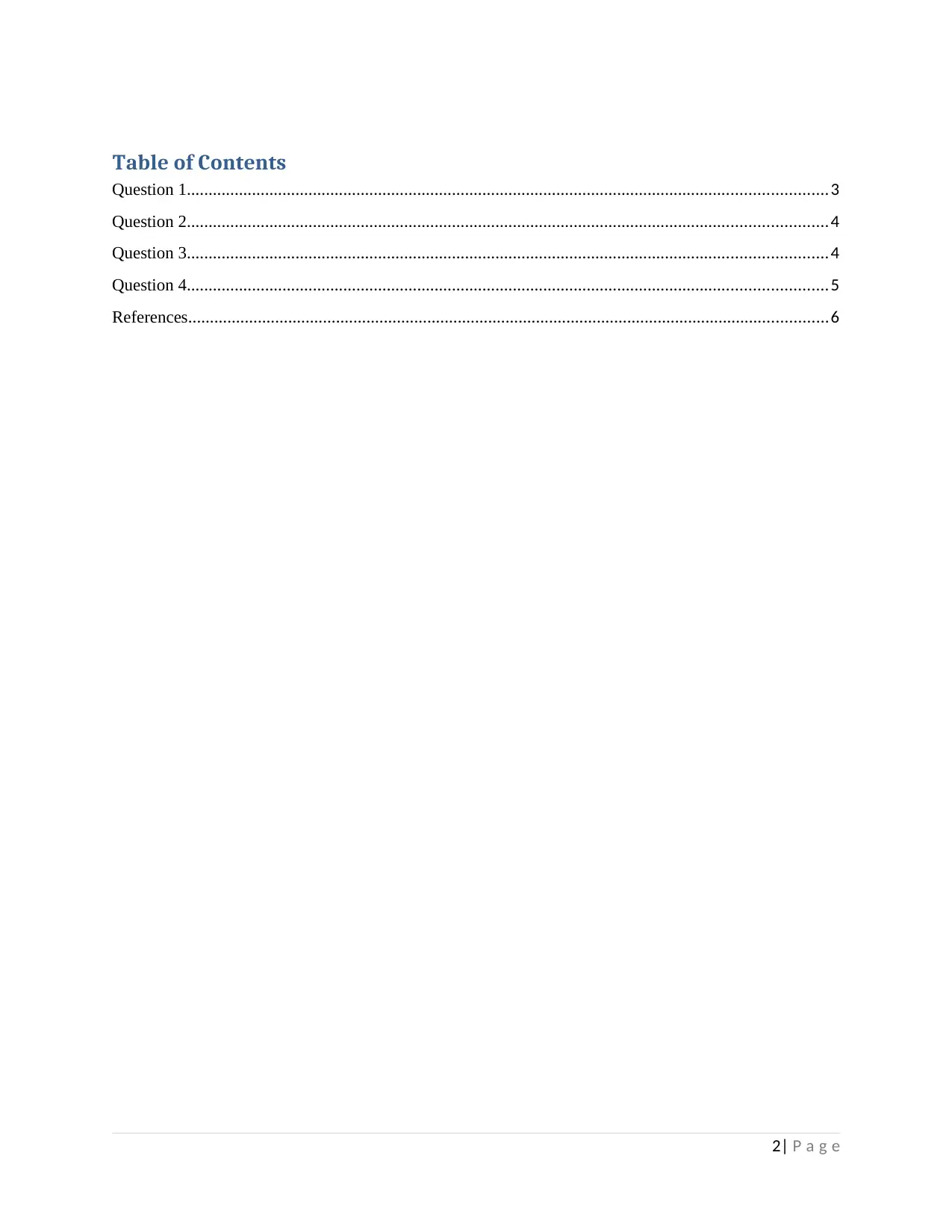
Table of Contents
Question 1...................................................................................................................................................3
Question 2...................................................................................................................................................4
Question 3...................................................................................................................................................4
Question 4...................................................................................................................................................5
References...................................................................................................................................................6
2| P a g e
Question 1...................................................................................................................................................3
Question 2...................................................................................................................................................4
Question 3...................................................................................................................................................4
Question 4...................................................................................................................................................5
References...................................................................................................................................................6
2| P a g e
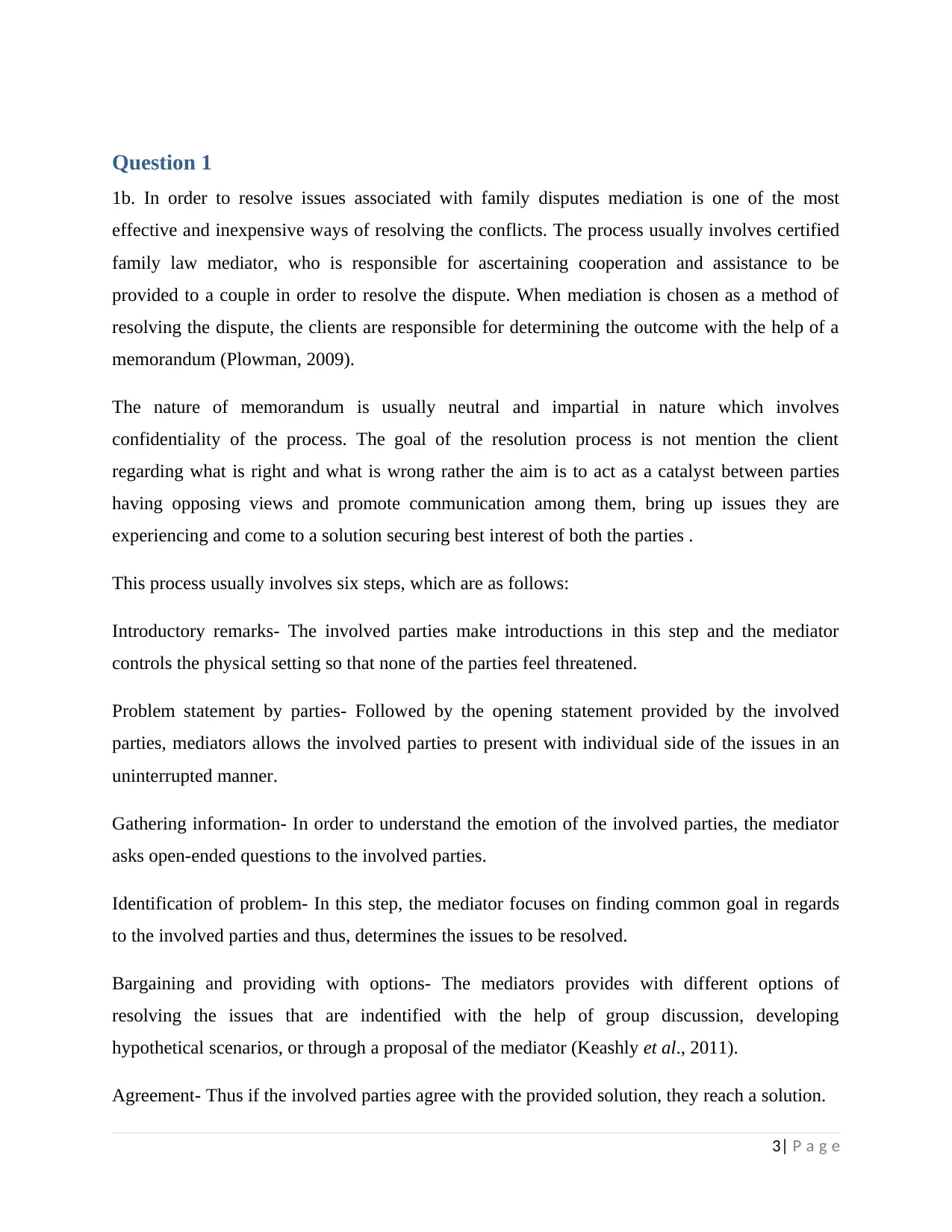
Question 1
1b. In order to resolve issues associated with family disputes mediation is one of the most
effective and inexpensive ways of resolving the conflicts. The process usually involves certified
family law mediator, who is responsible for ascertaining cooperation and assistance to be
provided to a couple in order to resolve the dispute. When mediation is chosen as a method of
resolving the dispute, the clients are responsible for determining the outcome with the help of a
memorandum (Plowman, 2009).
The nature of memorandum is usually neutral and impartial in nature which involves
confidentiality of the process. The goal of the resolution process is not mention the client
regarding what is right and what is wrong rather the aim is to act as a catalyst between parties
having opposing views and promote communication among them, bring up issues they are
experiencing and come to a solution securing best interest of both the parties .
This process usually involves six steps, which are as follows:
Introductory remarks- The involved parties make introductions in this step and the mediator
controls the physical setting so that none of the parties feel threatened.
Problem statement by parties- Followed by the opening statement provided by the involved
parties, mediators allows the involved parties to present with individual side of the issues in an
uninterrupted manner.
Gathering information- In order to understand the emotion of the involved parties, the mediator
asks open-ended questions to the involved parties.
Identification of problem- In this step, the mediator focuses on finding common goal in regards
to the involved parties and thus, determines the issues to be resolved.
Bargaining and providing with options- The mediators provides with different options of
resolving the issues that are indentified with the help of group discussion, developing
hypothetical scenarios, or through a proposal of the mediator (Keashly et al., 2011).
Agreement- Thus if the involved parties agree with the provided solution, they reach a solution.
3| P a g e
1b. In order to resolve issues associated with family disputes mediation is one of the most
effective and inexpensive ways of resolving the conflicts. The process usually involves certified
family law mediator, who is responsible for ascertaining cooperation and assistance to be
provided to a couple in order to resolve the dispute. When mediation is chosen as a method of
resolving the dispute, the clients are responsible for determining the outcome with the help of a
memorandum (Plowman, 2009).
The nature of memorandum is usually neutral and impartial in nature which involves
confidentiality of the process. The goal of the resolution process is not mention the client
regarding what is right and what is wrong rather the aim is to act as a catalyst between parties
having opposing views and promote communication among them, bring up issues they are
experiencing and come to a solution securing best interest of both the parties .
This process usually involves six steps, which are as follows:
Introductory remarks- The involved parties make introductions in this step and the mediator
controls the physical setting so that none of the parties feel threatened.
Problem statement by parties- Followed by the opening statement provided by the involved
parties, mediators allows the involved parties to present with individual side of the issues in an
uninterrupted manner.
Gathering information- In order to understand the emotion of the involved parties, the mediator
asks open-ended questions to the involved parties.
Identification of problem- In this step, the mediator focuses on finding common goal in regards
to the involved parties and thus, determines the issues to be resolved.
Bargaining and providing with options- The mediators provides with different options of
resolving the issues that are indentified with the help of group discussion, developing
hypothetical scenarios, or through a proposal of the mediator (Keashly et al., 2011).
Agreement- Thus if the involved parties agree with the provided solution, they reach a solution.
3| P a g e
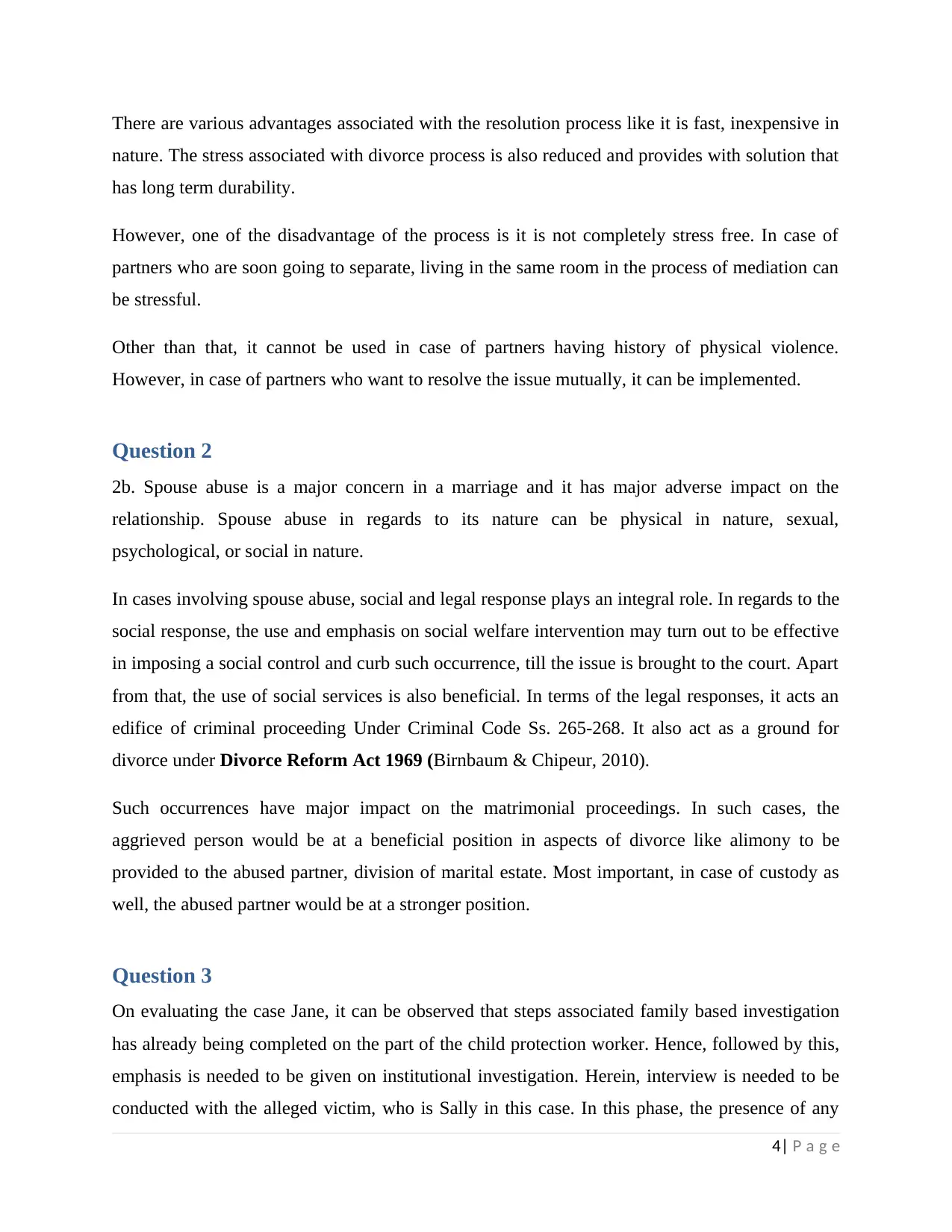
There are various advantages associated with the resolution process like it is fast, inexpensive in
nature. The stress associated with divorce process is also reduced and provides with solution that
has long term durability.
However, one of the disadvantage of the process is it is not completely stress free. In case of
partners who are soon going to separate, living in the same room in the process of mediation can
be stressful.
Other than that, it cannot be used in case of partners having history of physical violence.
However, in case of partners who want to resolve the issue mutually, it can be implemented.
Question 2
2b. Spouse abuse is a major concern in a marriage and it has major adverse impact on the
relationship. Spouse abuse in regards to its nature can be physical in nature, sexual,
psychological, or social in nature.
In cases involving spouse abuse, social and legal response plays an integral role. In regards to the
social response, the use and emphasis on social welfare intervention may turn out to be effective
in imposing a social control and curb such occurrence, till the issue is brought to the court. Apart
from that, the use of social services is also beneficial. In terms of the legal responses, it acts an
edifice of criminal proceeding Under Criminal Code Ss. 265-268. It also act as a ground for
divorce under Divorce Reform Act 1969 (Birnbaum & Chipeur, 2010).
Such occurrences have major impact on the matrimonial proceedings. In such cases, the
aggrieved person would be at a beneficial position in aspects of divorce like alimony to be
provided to the abused partner, division of marital estate. Most important, in case of custody as
well, the abused partner would be at a stronger position.
Question 3
On evaluating the case Jane, it can be observed that steps associated family based investigation
has already being completed on the part of the child protection worker. Hence, followed by this,
emphasis is needed to be given on institutional investigation. Herein, interview is needed to be
conducted with the alleged victim, who is Sally in this case. In this phase, the presence of any
4| P a g e
nature. The stress associated with divorce process is also reduced and provides with solution that
has long term durability.
However, one of the disadvantage of the process is it is not completely stress free. In case of
partners who are soon going to separate, living in the same room in the process of mediation can
be stressful.
Other than that, it cannot be used in case of partners having history of physical violence.
However, in case of partners who want to resolve the issue mutually, it can be implemented.
Question 2
2b. Spouse abuse is a major concern in a marriage and it has major adverse impact on the
relationship. Spouse abuse in regards to its nature can be physical in nature, sexual,
psychological, or social in nature.
In cases involving spouse abuse, social and legal response plays an integral role. In regards to the
social response, the use and emphasis on social welfare intervention may turn out to be effective
in imposing a social control and curb such occurrence, till the issue is brought to the court. Apart
from that, the use of social services is also beneficial. In terms of the legal responses, it acts an
edifice of criminal proceeding Under Criminal Code Ss. 265-268. It also act as a ground for
divorce under Divorce Reform Act 1969 (Birnbaum & Chipeur, 2010).
Such occurrences have major impact on the matrimonial proceedings. In such cases, the
aggrieved person would be at a beneficial position in aspects of divorce like alimony to be
provided to the abused partner, division of marital estate. Most important, in case of custody as
well, the abused partner would be at a stronger position.
Question 3
On evaluating the case Jane, it can be observed that steps associated family based investigation
has already being completed on the part of the child protection worker. Hence, followed by this,
emphasis is needed to be given on institutional investigation. Herein, interview is needed to be
conducted with the alleged victim, who is Sally in this case. In this phase, the presence of any
4| P a g e
Secure Best Marks with AI Grader
Need help grading? Try our AI Grader for instant feedback on your assignments.
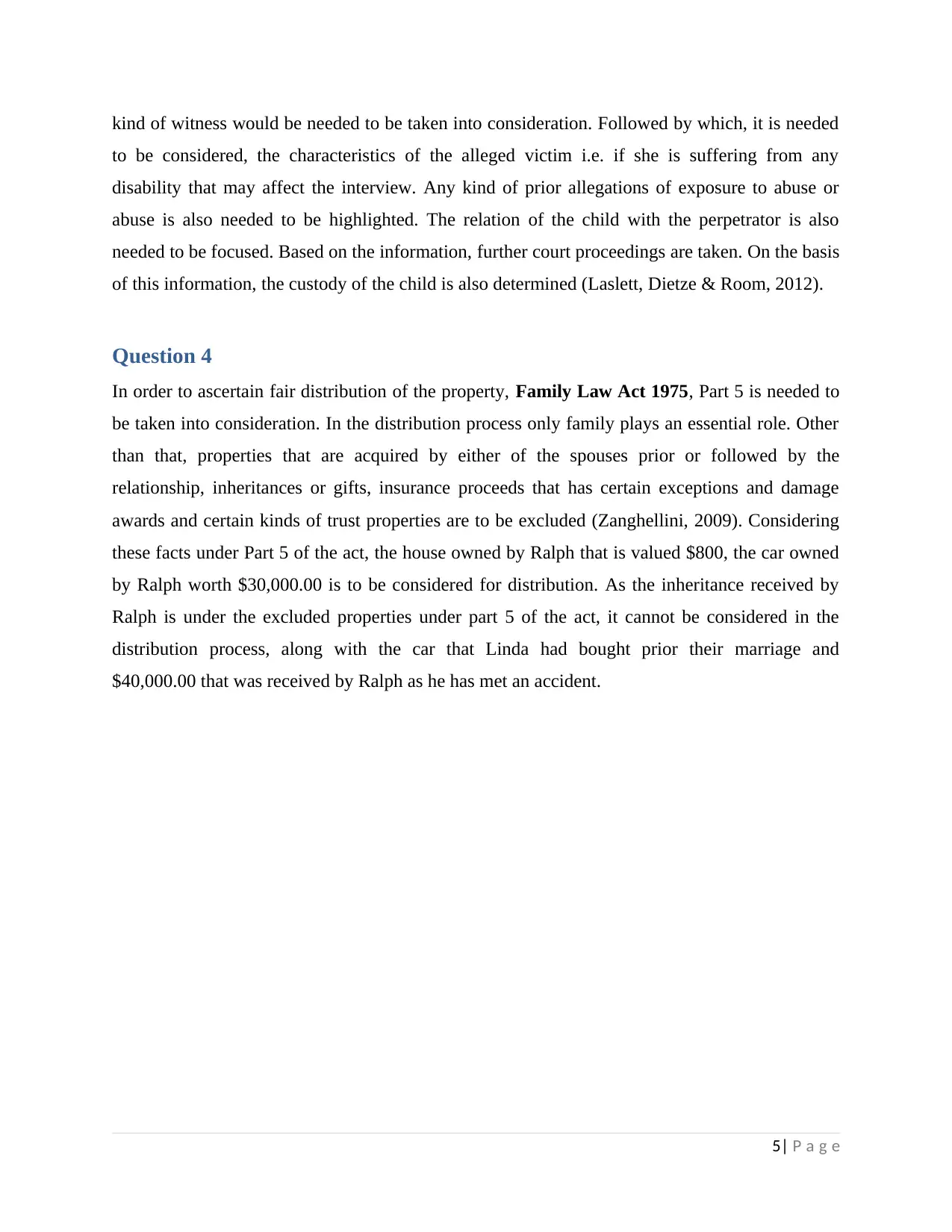
kind of witness would be needed to be taken into consideration. Followed by which, it is needed
to be considered, the characteristics of the alleged victim i.e. if she is suffering from any
disability that may affect the interview. Any kind of prior allegations of exposure to abuse or
abuse is also needed to be highlighted. The relation of the child with the perpetrator is also
needed to be focused. Based on the information, further court proceedings are taken. On the basis
of this information, the custody of the child is also determined (Laslett, Dietze & Room, 2012).
Question 4
In order to ascertain fair distribution of the property, Family Law Act 1975, Part 5 is needed to
be taken into consideration. In the distribution process only family plays an essential role. Other
than that, properties that are acquired by either of the spouses prior or followed by the
relationship, inheritances or gifts, insurance proceeds that has certain exceptions and damage
awards and certain kinds of trust properties are to be excluded (Zanghellini, 2009). Considering
these facts under Part 5 of the act, the house owned by Ralph that is valued $800, the car owned
by Ralph worth $30,000.00 is to be considered for distribution. As the inheritance received by
Ralph is under the excluded properties under part 5 of the act, it cannot be considered in the
distribution process, along with the car that Linda had bought prior their marriage and
$40,000.00 that was received by Ralph as he has met an accident.
5| P a g e
to be considered, the characteristics of the alleged victim i.e. if she is suffering from any
disability that may affect the interview. Any kind of prior allegations of exposure to abuse or
abuse is also needed to be highlighted. The relation of the child with the perpetrator is also
needed to be focused. Based on the information, further court proceedings are taken. On the basis
of this information, the custody of the child is also determined (Laslett, Dietze & Room, 2012).
Question 4
In order to ascertain fair distribution of the property, Family Law Act 1975, Part 5 is needed to
be taken into consideration. In the distribution process only family plays an essential role. Other
than that, properties that are acquired by either of the spouses prior or followed by the
relationship, inheritances or gifts, insurance proceeds that has certain exceptions and damage
awards and certain kinds of trust properties are to be excluded (Zanghellini, 2009). Considering
these facts under Part 5 of the act, the house owned by Ralph that is valued $800, the car owned
by Ralph worth $30,000.00 is to be considered for distribution. As the inheritance received by
Ralph is under the excluded properties under part 5 of the act, it cannot be considered in the
distribution process, along with the car that Linda had bought prior their marriage and
$40,000.00 that was received by Ralph as he has met an accident.
5| P a g e
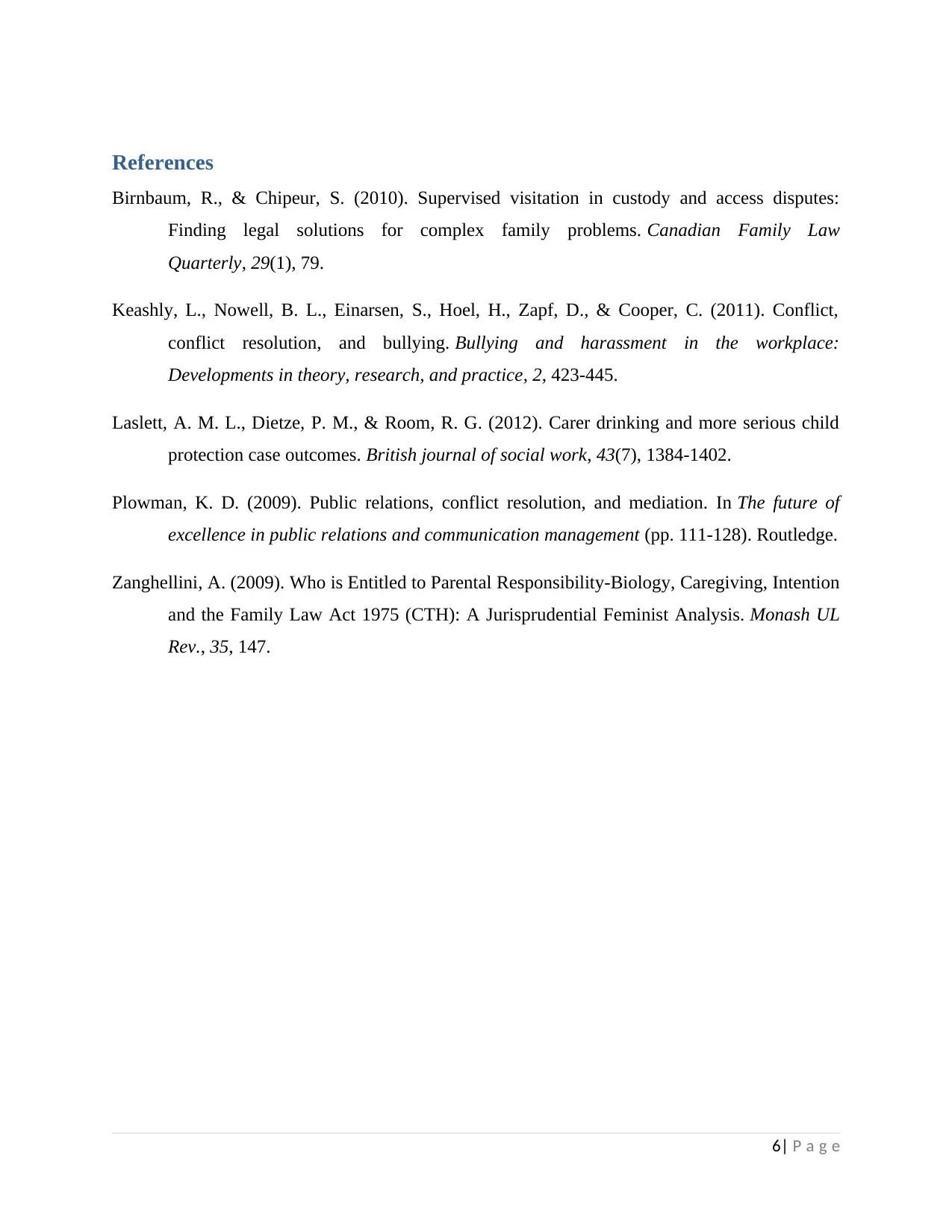
References
Birnbaum, R., & Chipeur, S. (2010). Supervised visitation in custody and access disputes:
Finding legal solutions for complex family problems. Canadian Family Law
Quarterly, 29(1), 79.
Keashly, L., Nowell, B. L., Einarsen, S., Hoel, H., Zapf, D., & Cooper, C. (2011). Conflict,
conflict resolution, and bullying. Bullying and harassment in the workplace:
Developments in theory, research, and practice, 2, 423-445.
Laslett, A. M. L., Dietze, P. M., & Room, R. G. (2012). Carer drinking and more serious child
protection case outcomes. British journal of social work, 43(7), 1384-1402.
Plowman, K. D. (2009). Public relations, conflict resolution, and mediation. In The future of
excellence in public relations and communication management (pp. 111-128). Routledge.
Zanghellini, A. (2009). Who is Entitled to Parental Responsibility-Biology, Caregiving, Intention
and the Family Law Act 1975 (CTH): A Jurisprudential Feminist Analysis. Monash UL
Rev., 35, 147.
6| P a g e
Birnbaum, R., & Chipeur, S. (2010). Supervised visitation in custody and access disputes:
Finding legal solutions for complex family problems. Canadian Family Law
Quarterly, 29(1), 79.
Keashly, L., Nowell, B. L., Einarsen, S., Hoel, H., Zapf, D., & Cooper, C. (2011). Conflict,
conflict resolution, and bullying. Bullying and harassment in the workplace:
Developments in theory, research, and practice, 2, 423-445.
Laslett, A. M. L., Dietze, P. M., & Room, R. G. (2012). Carer drinking and more serious child
protection case outcomes. British journal of social work, 43(7), 1384-1402.
Plowman, K. D. (2009). Public relations, conflict resolution, and mediation. In The future of
excellence in public relations and communication management (pp. 111-128). Routledge.
Zanghellini, A. (2009). Who is Entitled to Parental Responsibility-Biology, Caregiving, Intention
and the Family Law Act 1975 (CTH): A Jurisprudential Feminist Analysis. Monash UL
Rev., 35, 147.
6| P a g e
1 out of 6
Related Documents
Your All-in-One AI-Powered Toolkit for Academic Success.
+13062052269
info@desklib.com
Available 24*7 on WhatsApp / Email
![[object Object]](/_next/static/media/star-bottom.7253800d.svg)
Unlock your academic potential
© 2024 | Zucol Services PVT LTD | All rights reserved.





